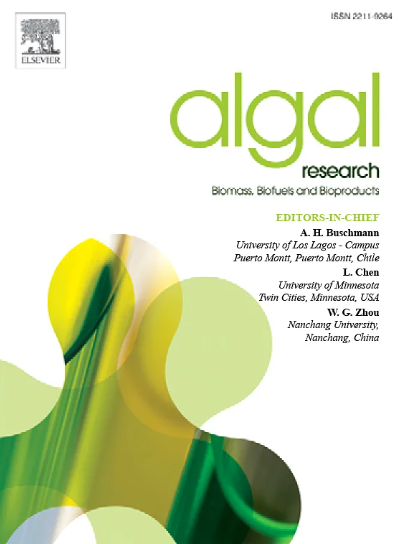Effects of salt concentration and trophic mode on glucosylglycerol and phycocyanin production by Arthrospira maxima
IF 4.6
2区 生物学
Q1 BIOTECHNOLOGY & APPLIED MICROBIOLOGY
Algal Research-Biomass Biofuels and Bioproducts
Pub Date : 2025-04-04
DOI:10.1016/j.algal.2025.104025
引用次数: 0
Abstract
Arthrospira maxima is an excellent cyanobacterial strain for phycocyanin production, while it has also recently been employed to produce a high-value product called glucosylglycerol that can be used as a cosmetic and food ingredient. In this study, the effect of NaCl-induced salt stress on cell growth, glucosylglycerol (GG) and phycocyanin (PC) production by A. maxima was investigated. The results suggested that the addition of NaCl effectively induced GG synthesis in cyanobacteria. The GG content increased from 0 % to the highest level of 15.29 % with increasing NaCl concentrations from 0 to 900 mM. However, the highest GG yield (174.54 mg L−1) was obtained at 600 mM NaCl as a higher NaCl concentration significantly reduced the biomass concentration. Furthermore, the PC content decreased from 17.44 to 9.72 %, and the PC yield sharply reduced from 333.63 to 80.00 mg L−1, indicating that increasing salt concentration adversely affected PC production. Consequently, the NaCl concentration of 300 mM was considered a suitable option for simultaneous production of PC and GG, under which both the high yields of GG (149.00 mg L−1) and PC (249.05 mg L−1) were achieved. Moreover, trophic mode markedly influenced GG synthesis in A. maxima. Photoautotrophic cells accumulated as much as 15.77 % GG in cyanobacterial cells, whereas only 6.28 % GG accumulated in mixotrophic cells, resulting in a significantly lower GG yield. In conclusion, the application of salt stress was an effective approach to producing GG under the photoautotrophic mode, and a medium salt concentration was the optimal option to simultaneously achieve high productivities of GG and PC. This study lays a foundation for efficient co-production of PC and GG, facilitating the high-value utilization of Arthrospira maxima.
盐浓度和营养方式对最大节螺旋藻产糖甘油和藻蓝蛋白的影响
最大节旋藻是一种极好的藻蓝菌菌株,它最近也被用来生产一种高价值的产品,叫做葡萄糖甘油,可以用作化妆品和食品成分。本研究研究了nacl诱导的盐胁迫对A. maxima细胞生长、葡萄糖甘油(GG)和藻蓝蛋白(PC)产量的影响。结果表明,NaCl的加入能有效诱导蓝藻中GG的合成。当NaCl浓度从0 ~ 900 mM增加时,GG含量从0 %增加到最高的15.29%,但在600 mM NaCl处理下GG产量最高(174.54 mg L−1),较高的NaCl浓度显著降低了生物量浓度。PC的含量从17.44%下降到9.72%,PC的产率从333.63 mg L−1急剧下降到80.00 mg L−1,表明盐浓度的增加对PC的生产有不利影响。结果表明,300 mM NaCl浓度可同时制备PC和GG,在此条件下,GG和PC的产率均较高,分别为149.00 mg L−1和249.05 mg L−1。此外,营养模式显著影响了大菱鲆的GG合成。光自养细胞在蓝藻细胞中GG的积累量高达15.77%,而在混合营养细胞中GG的积累量仅为6.28%,导致GG产量显著降低。综上所述,盐胁迫是光自养模式下生产GG的有效途径,中等盐浓度是同时实现GG和PC高产的最佳选择。本研究为高效产PC和GG奠定了基础,促进了最大节螺旋藻的高价值利用。
本文章由计算机程序翻译,如有差异,请以英文原文为准。
求助全文
约1分钟内获得全文
求助全文
来源期刊

Algal Research-Biomass Biofuels and Bioproducts
BIOTECHNOLOGY & APPLIED MICROBIOLOGY-
CiteScore
9.40
自引率
7.80%
发文量
332
期刊介绍:
Algal Research is an international phycology journal covering all areas of emerging technologies in algae biology, biomass production, cultivation, harvesting, extraction, bioproducts, biorefinery, engineering, and econometrics. Algae is defined to include cyanobacteria, microalgae, and protists and symbionts of interest in biotechnology. The journal publishes original research and reviews for the following scope: algal biology, including but not exclusive to: phylogeny, biodiversity, molecular traits, metabolic regulation, and genetic engineering, algal cultivation, e.g. phototrophic systems, heterotrophic systems, and mixotrophic systems, algal harvesting and extraction systems, biotechnology to convert algal biomass and components into biofuels and bioproducts, e.g., nutraceuticals, pharmaceuticals, animal feed, plastics, etc. algal products and their economic assessment
 求助内容:
求助内容: 应助结果提醒方式:
应助结果提醒方式:


